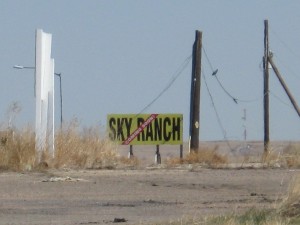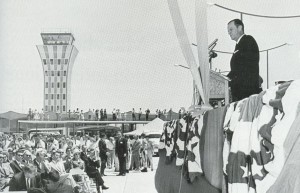
Period photographs, usually submitted by readers or from similar-themed Web sites, help define the histories of abandoned airports, such as this 1961 photo of Austin’s Robert Mueller Municipal Airport’s opening, with Austin Mayor Lester Palmer presiding.
By Ray Cober
At an unexpected intersection of aviation’s past and present, Paul Freeman discovered hundreds of stories waiting to be told from clues on an aeronautical chart.
“I’m a history buff and an aviation enthusiast, so I’ve always been interested in aviation history,” said Freeman. Once I started taking flight lessons and scouring over aero charts, I became intrigued by the abandoned airfield symbols on those charts—what this or that airport used to look like or if there’s anything left.”
By using the Internet, Freeman was able to discover the true picture of what those symbols represent.
“Once aerial photos became available on the Web, it gave me the ability to look at any spot in the country and see what it looks like from the air. That opened up the whole ‘God’s eye’ perspective.” Using these photos, eyewitness testimonies, official records and help from fellow aviation enthusiasts, Freeman began to piece together the histories of abandoned airports across the country. Since April 1999, his Web site, “Abandoned and Little-Known Airfields,” has chronicled more than 1,300 former airports in all 50 states and Puerto Rico, with detailed aerial photographs of each site.
“The Web site itself started out as a hobby. I was putting together whatever information I could find on a few airports, and the whole idea started to snowball. Once others started to read the Web site, people who’ve flown from the various airports or who lived in a town with an abandoned airfield started to send me unsolicited content, like ground or vintage photographs. It grew from me posting images of four or five airfields to the total I have now.”
Two recurring themes

Foundations of razed structures are often all that’s left of even recently abandoned airfields, such as the former main hangar of Aurora Airpark in Colorado.
Freeman quickly discovered two underlying themes while researching the nation’s abandoned airports: Hundreds of military airfields were often hastily constructed during the build-up for World War II and just as quickly abandoned at war’s end. Hundreds of civil airports, usually small general aviation airports but large international hubs as well, were closed by rezoning laws after being swallowed up by encroaching housing developments.
“When you fly in, you can see dozens of triangular-shaped paved runways dotting the desert. Given the desert climate, they’ll basically never disappear,” said Freeman as he described a typical WWII-era auxiliary Army airfield. These airfields were responsible for training thousands of airmen and accommodating aircraft from light trainers to four-engine heavy bombers. These airfields, usually built near larger U.S. Army airbases far from cities, were sparse and cheaply constructed, with little more than the distinctive three-runway pattern and extremely limited facilities. “Some of those closer to metropolitan areas have been reused, but a large number of them have sat dormant, never to be used again” said Freeman. Largely forgotten, these cracked and baked asphalt triangles nonetheless served a vital part of the war effort.
Abandoned intermediate airfields share a similar demise. These airfields, usually nothing more but large areas of graded and cleared land with beacons and other basic navigational aids, were built in the 1920s and 1930s to serve as emergency landing sites for early transcontinental airliners. As aircraft technology became more reliable, these fields, many of them rarely used, have been forgotten and absorbed by surrounding communities or the very land surrounding it. Once again, however, the arid climate and isolation of the Southwest has preserved many of these intermediate fields, perhaps some of the oldest and most untouched sites in the country.
However, not all abandoned fields are empty and isolated.
“There are a couple of interesting fields with huge blimp hangars that were used during WWII,” said Freeman. The former Tustin Marine Corps Air Station in Tustin, Calif., has two such hangars, made of wood to preserve strategic materials. These hangars and their intricate interior woodwork have been used in numerous television and film productions, and efforts exist to get at least one of the hangars on the National Historic Register. Other massive wooden blimp hangars exist in Weeksville, N.C. and Houston, Texas.
“From an architectural perspective, they’re amazing structures. I believe at one point they were the largest wooden structures in the world,” said Freeman. “Looking at them from the inside, they’re remarkable buildings — they have some amazing interior lattice wood structures.”
Some military airfields were abandoned even before completion, victims of the ever-changing pace of technology and politics. Boron Air Force Plant #72 Airfield, located in Boron, Calif., was built to support the production of exotic fuels for supersonic bombers that never materialized. Richard Bong Air Force Base in Burlington, Wis., named for America’s leading fighter ace of WWII, was to be a state-of-the-art Cold War defense station. Construction was halted when it was realized other, under-utilized bases in the area were available.
A political stance
Another issue surfacing on Freeman’s Web site is the tremendous number of general aviation airports that were built and then swallowed up by suburbia. “I would say that my Web site has taken on a political stance, so to speak, in that it’s become a lightning rod for advocates of GA airports across the country,” he said. “Hundreds and hundreds of them are lost across the country due to suburban growth and urban encroachment, and that’s something I’ve taken up as a real mission. It’s one thing I try to publicize, so pilots can get involved and lobby for their airports.”
Freeman’s own local airport almost became an example of the casualties of urban encroachment.
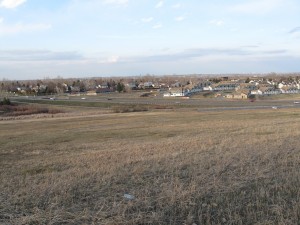
The residents of these homes and businesses in Littleton, Colo. are likely unaware that they’re living on top of Columbine Airport, as all traces are swallowed up by redevelopment.
“I was successful in testifying before the county council. They had a developer who was appealing for a zoning exception so it could build 15,000 homes adjacent to the runway barrier to the airport. Luckily it was shot down, but it was not a foregone conclusion.
“I get a lot of e-mails from people who are sad to learn that they didn’t even know there was an airport near their neighborhood; that seems to be a common story,” Freeman adds.
One of the most dramatic examples Freeman gave was Chicago’s Meigs Field, first operational in 1922. In 2003, with more than 80 years in operation and contributing 1,500 jobs and $57.3 million annually to the local economy, the airfield was forcibly closed by Chicago Mayor Richard Daley literally overnight, stranding all aircraft then present.
“That’s probably one of the most egregious examples. It was certainly extreme, but the pattern is pretty typical,” said Freeman. “There are special interest groups trying to redevelop, and always a lot of politics and money involved. Even in smaller municipalities, no one stops to think that the community is losing a resource. If people are losing an airport because frankly, these airports are not getting built, they’re really only being redeveloped — it’s sad to see how this is carried out, and there’s not a lot of recourse for after the fact.”
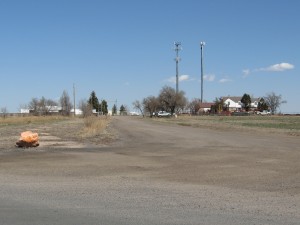
Many former airport structures are able to survive by being repurposed. The hangars of Sky Ranch Airport near Denver, Colo., now store construction materials.
Freeman also explained that airports are tempting acquisitions for developers because they’re open, clear, empty space. “Land is a finite resource,” said Freeman. “If you look at a swath of rural land and think about building a thousand houses on it, you’re looking at removing trees and clearing a lot of land. If you look at an airport, there’s a hangar here, a hangar there, but there’s land that doesn’t need to be cleared and leveled. Most of the work is already done for the developer.”
Many airports are built far away from cities to avoid this problem, but after decades of development, the cities begin to encroach on them.
“They build houses around an airport that’s been there for 30 years, and then people start complaining about the noise from the airplanes. That’s what was happening with the airport near my home — the airport has been here since the 1960s, and if the developer had its way and had a zoning exemption passed, there would have been homes less than 1,000 yards away from the runway,” said Freeman. “As anyone can tell you, there would be people complaining about the safety and noise with airplanes flying right above their homes. It’s the NIMBY syndrome — Not In My Back Yard — and it certainly doesn’t matter if the airport predates the homes by decades.”
Large, extensive international airports are not exempt. Freeman recounts his most memorable abandoned airfield.
“One that always surprises people, even people who live in the Dallas-Fort Worth area, is the amazing story of the Greater Southwest International Airport, which was built by the city of Fort Worth in the 1950s. Many people don’t realize the huge international airport that sits there now didn’t always exist there,” said Freeman. The airport had been built to serve both Fort Worth and Dallas as a major international hub, though no actual international flights were scheduled through the area. The terminal possessed a beautiful Art Deco interior, including an 18.5-karat gold leaf mural. Competition with Dallas’ Love Field and politics between the two municipalities reduced passenger traffic, and finally Federal Aviation Administration Chief Najeeb Halaby pressured the two cities to agree to a single airport, a new facility to be built near Greater Southwest International.

Greater Fort Worth International Airport, originally known as Amon Carter Field (after the then-current Fort Worth mayor), prior to completion,
“There’s one small segment of the runways that still exists, and it looks strange from the air when you’re flying into Dallas-Fort Worth. A lot of people who live in the area are surprised not only to learn that this huge airport ever existed, but that it was built, used briefly and then allowed to go to waste.”
Preserving history online
Amassing a Web site detailing the histories of more than 1,300 airfields means sorting through a mountain of photos, records and off-hand information, most if it sent by readers. To help streamline things, Freeman established some guidelines.
“The most difficult thing is organizing the information,” he said. “I get a lot of information sent to me electronically, which is great because people send pictures and text in an e-mail. But when people send me non-electronic material, it’s much more labor intensive to scan and type in the material.” Freeman prefers that photos are sent in JPEG format and that contributors send descriptions in e-mails rather than as separate attachments.
Some readers make regular contributions to the site, such as Chris Kennedy and his extensive personal collection of antique aeronautical charts, all financed through his own expenses.
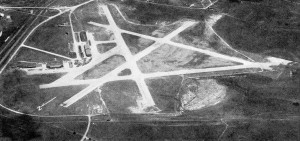
During its opening ceremonies, Greater Fort Worth International was touted as an advanced and ambitious international hub.
“When he knows there’s a write-up of an airport, he’ll go back in his archive and find the chart for that airport,” said Freeman. “I try to keep this Web site grounded in facts, especially the statistics about when an airport was opened and closed. You’ll find a lot of people who remember when an airport opened and closed; those recollections are wrong, as often an airport reopens and closes again. So Chris will send me a chart that shows me ‘the last depiction of an airport,’ in essence ‘proving’ when an airport ceased being operational. In some cases the time frame is pretty broad, but sometimes Chris or someone else will use additional facts to provide a more accurate picture.” Other major contributors include Jonathan Westerlane, who has submitted extensive field reports on the current conditions of abandoned sites; David Brooks, submitted resource who submits scans of vintage charts; and Brian Rehwinkel, who has performed exhaustive Internet searches and other data mining.
“A lot of the people who send in material do the same research I do—scanning publicly available databases— but they’re gathering more material than what I would be able to do myself. That’s the beauty of the Internet – all the information is out there, it’s just a matter of knowing what to look for,” said Freeman.
Preserving the present

The Amon Carter Terminal at Greater Fort Worth International featured an intricate mural covered in an acre of 18-karat gold.
Freeman’s experience with his own county has given him valuable insight to advise other pilots whose airports are threatened to be closed.
“There are many small GA airports that benefit their local communities in terms of business access, jobs and economic and emergency access, but frequently, many people only realize the value of an airport after it’s gone,” Freeman said. “So support existing airports where you can, and when zoning applications come up, get involved in the debate.”
For airports already gone, “Abandoned and Little-Known Airfields” ensures their stories will not disappear with them. “When I’m a passenger on commercial flights,” says Freeman’s introduction on his Web site, “I’ve always found myself looking out the window, constantly searching for airfields below. When I fly as a pilot myself, I’ve always tried to land at as many airports as possible to learn a little about each one.”
For more information on Freeman and “Abandoned and Little-Known Airfields,” visit [http://members.tripod.com/airfields_freeman/].












